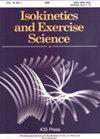自主等长收缩时阔肌活动的意义:预激活内阔肌以吸引中阔肌
IF 0.7
4区 医学
Q4 ENGINEERING, BIOMEDICAL
引用次数: 0
摘要
背景:由于股内侧阔肌(VM)和股中间阔肌(VI)在解剖学上存在联系,并由相同的股神经分支支配,因此它们之间可能存在潜在的关系。然而,这种关系尚未通过生理实验进行探讨。目的:本研究旨在使用肌电图(EMG)研究等长收缩时 VI 肌和 VM 肌的功能意义。方法:26 名健康男性志愿者在膝关节屈曲 90 ∘ 或 30 ∘ 时对 VI 肌、VM 肌和外侧阔肌(VL)进行了肌电图记录。在听觉刺激下快速伸膝时测量肌电图前运动时间(PMT)。此外,通过股神经刺激测定 M 波潜伏期,并从 PMT 中减去 M 波潜伏期,以计算降序传导时间(DCT)。结果:VM 的 DCT 最短,其次是 VL 和 VI。在膝关节屈曲 90∘时做最大努力时,VI-VM 的 DCT 差异明显大于 VI-VL。结论:VM受神经驱动充当预激活剂,为VI肌肉提供能量;当需要爆发性高动力伸膝时,这种趋势尤为明显。本文章由计算机程序翻译,如有差异,请以英文原文为准。
Significance of vasti muscle activity during voluntary isometric contraction: Pre-activation of vastus medialis for engaging vastus intermedius
BACKGROUND: A potential relationship may exist between the vastus medialis (VM) and the contractile efficiency of the vastus intermedius (VI) due to their anatomical connection and common innervation by the same branches of the femoral nerve. However, this relationship has not been explored using physiological experiments. OBJECTIVE: This study aimed to use electromyography (EMG) to investigate the functional significance of the VI and VM muscles during isometric contraction. METHODS: Twenty-six healthy male volunteers underwent EMG recordings from the VI, VM, and vastus lateralis (VL) at 90∘ or 30∘ of knee flexion. The EMG pre-motor time (PMT) was measured during rapid knee extension in response to an auditory stimulus. Additionally, the M-wave latency was determined by femoral nerve stimulation and subtracted from the PMT to calculate the descending conduction time (DCT). RESULTS: DCT was shortest at VM, followed by VL and VI. The DCT difference of VI-VM was significantly greater than that of VI-VL during maximal effort at 90∘ of knee flexion. CONCLUSIONS: VM is neurally driven to act as a pre-activator that primes the VI muscle; this tendency is particularly pronounced when explosive high-moment knee extension is required.
求助全文
通过发布文献求助,成功后即可免费获取论文全文。
去求助
来源期刊

Isokinetics and Exercise Science
医学-工程:生物医学
CiteScore
1.20
自引率
14.30%
发文量
37
审稿时长
>12 weeks
期刊介绍:
Isokinetics and Exercise Science (IES) is an international journal devoted to the study of theoretical and applied aspects of human muscle performance. Since isokinetic dynamometry constitutes the major tool in this area, the journal takes a particular interest in exploring the considerable potential of this technology.
IES publishes studies associated with the methodology of muscle performance especially with respect to the issues of reproducibility and validity of testing, description of normal and pathological mechanical parameters which are derivable from muscle testing, applications in basic research topics such as motor learning paradigms and electromyography. The journal also publishes studies on applications in clinical settings and technical aspects of the various measurement systems employed in human muscle performance research.
The journal welcomes submissions in the form of research papers, reviews, case studies and technical reports from professionals in the fields of sports medicine, orthopaedic and neurological rehabilitation and exercise physiology.
 求助内容:
求助内容: 应助结果提醒方式:
应助结果提醒方式:


